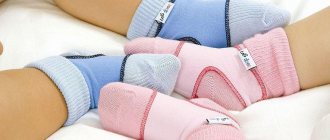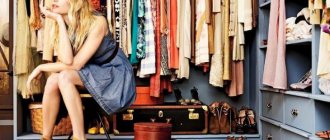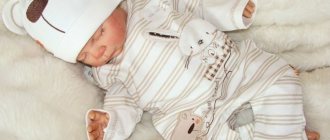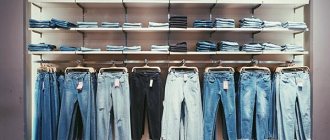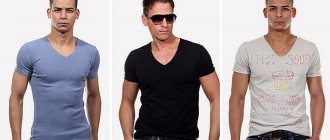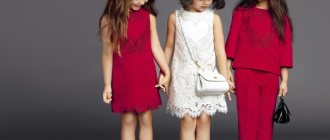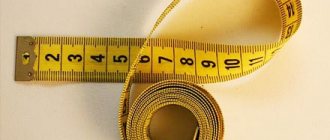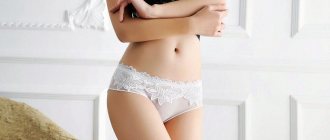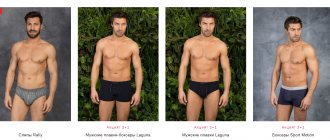“Have you put on your hat?” - this question from caring loved ones haunts us from childhood to old age. But we often shy away from this item of clothing. And not so much because we want to maintain our hairstyle, but for a much more banal reason - often a hat is simply inconvenient. For example, it fits the head too tightly, depriving the hair of its fullness and leaving red stripes on the forehead. Or, on the contrary, every now and then it tries to slide into your eyes.
Hatred for an uncomfortable hat is often born in childhood and affects one’s health. To prevent this from happening to your child, you need to learn how to choose a hat that is comfortable and most suitable for him.
Below we have collected detailed information on how to choose the size of a children's hat (as well as hats, caps, baseball caps) and what you need to pay attention to so that wearing a headdress gives your child pleasure.
How to determine the size of a children's hat
The easiest way to choose the right hat for your child is to try it on and choose the one that “fits” best. But this option only works in one case: if you buy a hat in a store, or, say, at the market.
Those who have tried online shopping at least once in their life know how unprofitable offline shopping is. A hat, cap or bonnet produced by a well-known brand, carefully tailored and made of high-quality materials, when purchased in a regular store, will cost you 3-4 times more than the same thing bought on ebay or, for example, in the online stock 6PM.
In order not to waste money, it makes sense to buy a hat, like other items of clothing, online. But how to choose the right size for a children's hat? That's how.
Traditionally, hat size is the circumference of the head, measured in centimeters.
Take a soft tailor's ribbon and wrap it around the child's head - approximately along the line along which the bottom border of the hat will "sit": above the eyebrows, over the ears (or behind them - depending on whether the headdress should cover them) and at the most convex part of the back of the head. Do not pull the flexible “centimeter”, it should lie freely!
The measured value is the size of the children's hat you need.
In the absence of a measuring tape, you can use a regular lace, which you then simply need to attach to any ruler.
Formula for calculating normal indicators
Every parent can measure the diameter of a child's head. This can be done easily using a special formula. After calculation, its data are compared with the indicators in the table. Let's take the baby's age as approximately 6 months. At this age, the head circumference is usually 42-43 cm. To find out the normal figure, you need to subtract 1.5 cm from each previous month for each month. Example: the diameter of a four-month-old baby's head is 41 cm (41-1.5-1.5=38).
From the age of six months the formula changes slightly. Example: The head size of a nine-month-old baby is 45 cm (45-1.5-1.5=42). These formulas help to calculate the normal dimensions of the skull, but they will only be approximate, because it is also worth taking into account the gender of the toddler (boy or girl), as well as its genetic characteristics. Data for children of different ages and gender can be found in the table.
Children's hat size chart
Size in centimeters is the most accurate, but not the only way to “measure” a headdress. Manufacturers often indicate the age of the child as the hat size - for example, 3-5 years, or 7-9.
In principle, this is also true: such hats will fit perfectly on an average child of the appropriate age. But if your child develops at an individual pace and is ahead of his peers in size (or, on the contrary, is behind them), this must be taken into account and choose a hat designed for a slightly older (less) actual age.
To avoid confusion, we have compiled a table of sizes, indicating in it the correspondence between traditional sizes in centimeters and in the “age” and “height” formats.
| Hat size | Head circumference (cm) | Height (cm) | Age |
| 56–58 | 58 | 146–152 | 12 years |
| 56–57 | 57 | 140–146 | 11 years |
| 56 | 56 | 134–140 | 10 years |
| 56 | 56 | 128–134 | 9 years |
| 55 | 55 | 122–128 | 8 years |
| 54 | 54 | 116–122 | 7 years |
| 53 | 53 | 110–116 | 6 years |
| 52 | 52 | 104–110 | 5 years |
| 51 | 51 | 98–104 | 4 years |
| 50 | 50 | 92–98 | 3 years |
| 49 | 49 | 86–92 | 2 years |
| 48 | 48 | 80–86 | 1.5 years |
| 47 | 47 | 74–80 | 12 months |
| 46 | 46 | 68–74 | 9 months |
| 44 | 44 | 62–68 | 6 months |
| 40 | 40 | 56–62 | 3 months |
| 35 | 35 | 50–54 | newborn |
Differences in size numbering from different manufacturers
Manufacturers of hats use 4 options for size numbering.
- dimensions with intervals equal to 1;
- sizes with even number intervals: 2-4;
- double sizes;
- combinations of sizes: age - size, height - size.
There are manufacturers who meet the needs of consumers; they supply hats with a size stabilizer.
How to choose the right baby hat size
The table shows that an average 6-month-old baby will need a hat or cap of size 44. For a 9-month-old - 46.
If your child’s age falls between two sizes, you need to choose a suitable headdress based on several parameters:
- seasonality . A summer hat should fit more tightly - so it is better to choose the smaller size of the two offered. Winter, on the contrary, due to its thickness and massiveness, should have some space for planting - choose a larger size;
- material . If it is thin, soft, elastic, choose a size slightly smaller. If it is dense and non-stretchy - more;
- form . If the hat has a wide knit trim that provides a snug fit on the head (example: a helmet hat), or drawstring ties, you can choose a larger size - you can adjust the fit if necessary. If there are no ties or knitted tapes that would ensure a tight fit, choose a smaller size to protect your baby from drafts;
- child's age . In the first 3 months of life, the baby's head circumference grows by about 2 cm every month. At the age of 3 months - 1 year - approximately 0.5-1 cm monthly. Over the course of a year, from one to two years, the head grows by about another 2.5 cm. But from two to ten years, growth does not occur so spasmodically - approximately 0.5 cm annually. Considering this, it is clear: for a small child you should take a hat about a size larger, otherwise he will outgrow it very quickly. But if your baby has already reached the age of 2 years or older, you can choose a “true to size” model - it will serve your son or daughter for at least a year or two.
Features of dimensional grids
Most manufacturers' tables are based on the child's head circumference. However, there are some nuances here too:
- in the grids with the sizes of hats for newborns, the age (from 0 to 12 months) and height of the baby (from 50 to 80 cm) are indicated; the size range is in the range from 35 to 47;
- in the tables for children from 1.5 to 3 years old, the head circumference (48 to 58 cm) and height (from 80 to 158 cm) are indicated, sizes 48-58 correspond to the head circumference;
- sometimes in the tables only the age of the child is used as the main indicator for determining the size, but not all children of the same age category have the same development and body parameters, so the size may be inappropriate;
- In some size charts there are also so-called double sizes, for example, 35-39.
Terminology and types of hats
You may be surprised, but there is a whole “Big Dictionary of Headdresses”, a significant part of which is still in use. Even the seemingly simplest caps or berets have dozens of options and sub-options. It’s difficult to understand all this in detail, and it’s not worth it. Let's just try to highlight the main types of children's hats in order, firstly, to navigate their endless variety, and secondly, to simplify our life when searching for and choosing a hat in an online store.
A cap
The constant leader is the hat, a collective term that in the vast majority of cases means a traditional headdress with a more or less loose cut. It may vary the material, the thickness of the fabric, the design may change slightly (for example, the presence or absence of a pom-pom), but the general features are almost always the same and upon request “boys hat” you will receive a set of items of approximately the same style.
A classic hat without restrictions may contain various prints, patterns, ties, buttons, rhinestones... Of course, a coarse knitted children's hat with a pompom looks a little different than a finely knitted model with patterns and rhinestones, but nevertheless, both options are a hat, aka hat.
Beanie
A beanie hat that fits tightly to the head was once the privilege of working people, athletes, and climbers. But this practical model was quickly appreciated by young people, always hungry for fresh ideas, and then everyone else caught up.
The origin of the term is still debated, ranging between the French "bejaunus" (yellowmouth) and the English "bean" (bean). Despite the simplicity of the design, the beanie is fashionable, fresh and practical, because one of the advantages of the traditional beanie hat is the fact that it takes up extremely little space - no more than a sock, and will fit into any pocket or even pocket.
Baseball cap
Oddly enough, the baseball cap actually has a direct connection with the truly American sport of baseball. In the 50s of the last century, this sports cap with a characteristic visor that protected the players’ eyes from the sun was introduced as an accessory and element of the baseball player’s uniform. Almost immediately, fans acquired similar models, and very quickly the baseball cap ceased to be exclusively a sports headdress.
Everyone liked the design, and when it turned out that various designs could be applied to a baseball cap, a real epidemic began. After all, these caps have become advertising products - along with keychains and pens. Now there are so many options that even a winter insulated baseball cap with natural fur won’t really surprise anyone.
Panama
The straw hat, which gave this headdress its name, is almost no longer associated with it. But, seeing the familiar narrow brim and thick fabric, “Panama hat” (or “Panama hat”, depending on your taste) immediately comes to mind. In fact, what we used to call a Panama hat is the so-called “bucket”, or bucket hat.
The “bucket” was invented by British farmers at the beginning of the 20th century. Then it became popular among fishermen who appreciated the convenience and comfort. As a fashion accessory, the headdress began its journey after the Vietnam War, where it was part of the equipment of American soldiers.
The model’s convenience, comfort and stable demand have led to the fact that the “bucket” Panama hat is invariably present in the catalogs of almost all fashion brands. Well, a children's Panama hat is an accessory that you can't do without on any summer walk.
Deviations from norms
It is impossible to diagnose a disease based on a single indicator that deviates from the generally accepted ones. If the baby has a large or small head, then the pediatrician and neurologist are required to pay attention not only to the size of the head, but also to the measurements of chest circumference, weight, pelvic volume, and build. It is useful to look at the parents' children's medical records. Perhaps the deviations are inherited.
Parents and doctors should be alarmed in the following situations:
- The baby's skull is too large, veins protrude on the head, the fontanelles are large and convex, the forehead is large and protrudes strongly forward. In this case, the baby may have hydrocephalus. The exact diagnosis needs to be determined after ultrasound, measurements of fluid in the brain, based on MRI data.
- The skull is small and underdeveloped. Simultaneously with the minimum head circumference, the baby exhibits neurological disorders, the forehead is low and small, and the fontanelles have closed prematurely. In this case, the pediatrician suspects microcephaly.
Moms should know! It is important that the head circumference of a one-year-old child does not exceed the chest measurement data.
They approach each other at three to four years of age. If a serious discrepancy is found, you should immediately consult a doctor.
Material
When choosing a children's hat, preference, of course, should be given to natural fabrics. Polyamide, acrylic and other synthetics can only boast of durability and low cost. But ideally it can be present only as a small percentage in the form of elastane, to give shape. A synthetic hat will not bring any comfort either in winter (it is simply cold) or in summer (in fact, it is a plastic bag on the head).
Therefore, only cotton and wool, and of good quality. Silk is added to fabric very rarely, and even then only in the case of expensive hats from various pretentious brands, so it is rather exotic.
Let's sum it up
Each child has its own individual characteristics, including the diameter of the head. Some babies are born with a large body weight, others with a smaller one, the same applies to volumes. It is impossible to name clear boundaries of certain indicators that would certainly indicate any deviations. In medical practice, only average data are used, which doctors rely on. Only a specialist can judge the presence or absence of certain problems in your child after a general examination and the necessary diagnostic methods.
Care
If washing is necessary, you must carefully study the information label inside the product. Cotton hats can be washed without any problems at 30 degrees in an automatic washing machine. However, it is worth remembering to choose a short program (30-40 minutes), and the spin speed should be as low as possible. Wool is washed only on a special gentle cycle in cold water.
You cannot spin woolen items in automatic mode at all. It’s a good idea to follow the rule “wash dark with dark, and light with light,” and good laundry detergents won’t hurt either. You shouldn’t overuse laundry detergents; the formula “the more the better” definitely doesn’t work here: excess detergent will affect the color and condition of the headdress. Add exactly the recommended amount of powder or even less than specified.
For good woolen hats, which are not cheap, manufacturers, to play it safe, recommend exclusively dry cleaning as care. Even so, a gentle hand wash in cold water and mild soap won't hurt.
The advantage of synthetic hats, in addition to the low price, is durability. They can be washed at least every day.
How to correctly measure the size of a child's head at home
Let's figure out how to correctly measure the head diameter of a newborn and older children at home using a centimeter. Measurement algorithm:
- The readings are taken in such a way that the measuring tape passes clearly through the area of the occipital protuberance of the baby.
- From the front, a centimeter is placed through the child’s brow ridges.
- You should also measure your chest using a centimeter. In front, the tape is laid in the area of the nipples, and in the back through the lower part of the shoulder blades.
It must be remembered that during the procedure the little one must be calm. If he wriggles and cries, it is unlikely that it will be possible to take exact measurements (more or less). In small children, the body looks a little disproportionate in relation to the head. It's quite normal. Already in a one-year-old toddler this feature will not be so noticeable. With age, the torso becomes more and more proportional. Teenagers aged 12-14 years old have a body that looks like an adult.
You should worry in a situation if the size of the baby’s head deviates greatly from the norm. In such a situation, it is urgent to show the child to a doctor.
Brands
There are few well-known brands that do not offer children's hats in their children's collections. True, this applies to boys and girls of preschool and school age. Products for children under 2-3 years of age are most often sold by individual brands. The list of manufacturers, as you understand, can be endlessly long. But we, guided by the theme of our site, namely shopping in foreign online stores, tried to make it as short and useful as possible. The goal, as usual, is to suggest how you can spend less and get more.
GAP
Gap.com
This American brand probably doesn't need any special introduction. There aren't many places left on the planet where you can't find clothes with a recognizable logo. Decent quality for the lowest possible price. And this ratio is so successful that entire generations have grown up in GAP. It is preferred by both students and billionaires. At GAP you are always young, serious, rational and respectful of tradition. It's more than just clothes.
The GAP logo baseball cap is a classic. GAP has a solid range of children's hats, including for the little ones. The “economy” category implies the use of synthetics. Therefore, always pay special attention to this point.
Prices : A GAP children's hat, depending on the model, will cost $15-20. But, taking into account the store’s inherent policy of mass “super sales”, you can quite count on a discount of 50% or more.
Where to buy : Official GAP. com is a great choice, but orders are only shipped within the United States. You can place an order in the store and international delivery by contacting any of the mail forwarding companies - for example, Pochtoy. com. You will find a huge selection of products from both GAP itself and related brands, such as Old Navy or Banana Republic, on ebay.com.
Bench
A fairly young British brand, Bench, has managed to win the hearts of many fans of good clothing. An excellent combination of youth fashion, practicality, quality and reasonable prices.
High-quality materials and decent tailoring will not leave anyone indifferent, including middle-aged and older people. The selection of children's hats is impressive, but recently many models made from 100% synthetics have appeared, so do not lose sight of this point.
Prices : The cost of a Bench children's hat ranges from 5 to 15 euros.
Where to buy : The brand is in the process of reorganization, but there is an official representation on the German Amazon.de, and the best prices not for children's hats, but for Bench clothing in general, will be offered by the German ebay auction.
Polo Ralph Lauren
Ralphlauren.com
The embodiment of the American dream - Ralph Lauren, a boy from a simple, poor family, without special education, who “created himself”, became one of the most famous designers of his time and the richest man. A brand that embodies true success. And everywhere. Oscar for costumes, uniforms for the US Olympic team, 50 years of Polo Ralph Lauren at the crest of fashion - the list is truly endless.
Ralph Lauren's surprisingly successful combination of English aristocratic restraint and sporty practicality is always a win-win choice. There is a large selection of children's hats: baseball caps, panama hats, beanies, for any age. In the official store, for an additional fee, you can add your own design to the baseball cap. The geography of production depends on the collection, with Sri Lanka being the most common location.
Prices : Various adjectives apply to Ralph Lauren products, but “inexpensive” is not among them. Children's hats - from 15 to 40 euros.
Where to buy : The official American online store RalphLauren.com is very loved by our compatriots, especially during sales periods. Here you can easily place an order with delivery to the address of a forwarding company with a warehouse in the USA. A truly huge selection of Ralph Lauren merchandise can be found on ebay.com - particularly from US seller BHFO, which offers low-cost direct international shipping.
Tommy Hilfiger
Tommy.com
Designer Tommy Hilfiger has not been associated with the brand of the same name for more than ten years, but nevertheless, the products of this brand are selling quite well - thanks to the successful combination of price and quality, style and practicality. Countries of production: China, Ethiopia.
Prices : Not cheap - children's hats cost 10-20 euros.
Where to buy : The Russian online store Tommy Hilfiger offers models from the latest collections, but will not please you with low prices. But the ebay.com site will offer such an assortment of children’s hats, and other products from this brand, that it’s easy to get confused. Be sure to check out the BHFO seller mentioned above.
S.Oliver
soliver.de
The Bavarian brand S. Oliver comes from Southern Germany, the city of Wurzburg. A true embodiment of German tradition: practical, high quality, at a fair price. Will not leave anyone indifferent. A large selection of both children's clothing in general and hats.
Prices : A children's hat will cost 15-20 euros, but discounts on seasonal sales reach 60-70%, so there is almost always an opportunity to get an excellent product at a good price.
Where to buy: A good selection of children's hats from this brand, in addition to the official online store soliver.de, will also be offered by the German Amazon, where the brand is officially represented.
Brands Aliexpress
Aliexpress.com
Surprisingly, small manufacturers from China, whose goods are offered mainly on the Aliexpress platform, deserve close attention. You can see this for yourself by reading the assortment, number of orders and quality of reviews.
Of course, there are frankly few fabrics such as 100% merino wool, and even with the addition of silk or cashmere, but cotton is of fairly good quality. Many different models - both for the smallest and for older children. In any case, there is plenty to choose from on Aliexpress. It is probably unnecessary to remind you that when choosing among the abundance, you should focus primarily on reviews and the number of orders. Also use our seller screening tool.
Prices : More than reasonable, considering free international shipping. Sometimes you can buy an excellent children's hat for just a few dollars.
Reasons for deviation up or down
At birth, the doctor assesses the volume of the newborn's skull and chest. It often happens that the baby has a large head stretched back, or, on the contrary, it is small. There are a number of reasons why an infant may experience such disorders. But minor deviations are not considered pathologies. In large children, head sizes may exceed the upper values in the table.
Large parents often give birth to children with body parameters that differ from the average norm, and if mom and dad are not large in size, their babies may also inherit this feature of their body constitution. If there are strong deviations from the norm, parents should not ignore this sign; they should definitely look for the cause.
Learn in detail about the development of boys and girls from birth to one year. All the necessary information is here.
Hydrocephalus
The causes of an enlarged skull in a child include such a serious illness as hydrocephalus or dropsy of the brain. The pathology is characterized by the accumulation of fluid in this area. In this case, symptoms such as increased intracranial pressure, nausea, eye pain, mental disorders, neuralgic abnormalities, and a pathologically large head in the baby are noted.
Microcephaly
This disease occurs in both full-term babies and premature infants. If the baby was born with a small skull size, doctors may suspect microcephaly. This refers to a condition in which the patient's brain growth stops. The shape of the head takes on an irregular shape. Another name is brain hypoplasia. At the same time, the growth of the skull itself is disrupted, but the rest of the baby’s organs develop in accordance with the norms. Diagnosis of brain hypoplasia is carried out using ultrasound and other methods.
The disease has a negative impact on the development of the central nervous system of the toddler. This provokes mental retardation and many neuralgic abnormalities. The severity of the disease can range from mild to extremely severe. Microcephaly is considered an incurable disease. If a baby is born with such a deviation, the goals of treatment are to adapt such a patient to social life.
Photos of hydrocephalus and microcephaly
This photo shows hydrocephalus.
This is what microcephaly looks like
Both diseases are considered very serious and require constant medical monitoring.
Newborn headdress
The first hat a newborn wears is called a cap. The material from which it is made must be natural, usually cotton. In hot weather, it breathes and prevents the baby from sweating; in cold weather, it effectively retains heat, protecting the baby from freezing. Caps are often made with wool or silk content. Manufacturers of children's clothing offer a large number of styles and colors.
Additional Information. In addition to the fact that the cap warms the baby, it creates additional protection for the baby's fontanel, which remains open for some time. It closes completely by the year. Until this time, the appearance of the fontanelle is one of the main indicators of the baby’s health. Pediatricians always feel it during examinations.
Caps for newborns
If the baby is discharged from the hospital in cold weather, you must first ensure that the child is warm and comfortable. While many parents try to dress their baby so that he looks better in photographs. Nowadays it is fashionable to organize photo sessions for newborns. When creating images of girls, elastic bands and headbands are used. They also need to be carefully selected so that they do not put too much pressure on the child and are made without the use of synthetic materials.
Features of hats for newborns
If the hat has buttons or other fasteners, you need to make sure that they will not put pressure or injure the baby’s delicate skin.
Note! There should be no rough seams or labels inside that cause inconvenience. Typically, baby clothes have seams on the outside. When they are inside, you need to make sure they are safe.
If the hat has ties and fasteners at the back, then it is better to abandon it. Newborns sleep a lot, outside almost all the time in a stroller. Therefore, the mechanisms at the back will cause discomfort. When there are appliqué elements on the hat, you need to pay attention to where they are located, whether they will interfere with the baby’s ability to sit comfortably in the stroller. Until three months, it is better to wear simple hats for the baby, without additional elements for beauty. At this time, the child's main concern is comfort. Patterns, rhinestones, bows are made exclusively for parents to attract their attention. They do not affect the quality and properties of the headdress.
If the hat is made of wool, which will prick the baby's skin, you should wear a thin cotton cap underneath. The main thing is to ensure comfort. If the material from which the headdress is made is natural, it will allow the child’s skin to breathe. It should be soft and pleasant to the body. It is better for the hat to be elastic and stretch when necessary. When your baby is indoors, you can use a larger hat.
The simpler the headdress, the better. It should not interfere with the baby’s movements or hamper them. There is no need to buy a lot of hats. Babies grow very quickly and hats become small.
When children spin around and act up, their hats move and may fall off. That's why many have soft elastic bands sewn into them along the edges. Other hats have ties. In this case, you need to carefully ensure that they do not injure the baby’s skin or restrict movement. It is better to use such hats in strong winds. Children don't really like these types of hats.
Baby in a hat with strings
Saving on children's things
Parents face significant costs for their children. This includes clothes, food, and toys. Don't miss the chance to save money, because children grow quickly and clothes almost instantly become small.
Saving method 1
Children often wear out clothes one after another. The child grows quickly, and things do not have time to bear. So the same sliders can be used by three different babies during their infancy. These are the clothes that are washed most often; they are not intended “for going out”, but are created specifically for the physiological needs of the child. There is no point in spending money on such a product, because you won’t have to wear it for long.
You can ask about children's things from people who know children older than your own. These things are probably gathering dust without use, although they still look quite decent. If this is not your first child, then there will be no problems with this.
Saving method 2
Second hand is the cheapest store you can imagine. You can save on children's things by shopping there. Don't forget to do extra washing after purchasing. There are second-hand stores even in small towns. They are usually located on the first floors and have signs with large letters. It's hard not to notice these. You can find out the addresses of similar stores in your city via the Internet.
Saving method 3
You can make many things for your child yourself. Expectant mothers love to knit booties and outfits for their future babies. You can sew the rompers yourself by purchasing cotton material. Many handicraft magazines offer their instructions for making children's clothing, and master classes can also be found on the Internet.
It is better to sew and knit clothes for a child during pregnancy. During maternity leave there is always free time, but with the birth of a child there will be none, even while the baby is sleeping.
Saving method 4
Children's sales allow you to save big. Pay attention to promotions and discounts in children's stores, do not miss the opportunity to buy things cheaper. Plus, you can look forward to the future. Winter clothes in summer are much cheaper than in the cold season.
Children are the most valuable thing in a person’s life. The health of your own child is extremely important. The correct selection of clothing affects the baby’s health, so you need to approach this issue with special responsibility.
At what time does a baby start to roll over, read a lot of useful information there. Do you know at what age girls can be imprisoned? All information on the link

